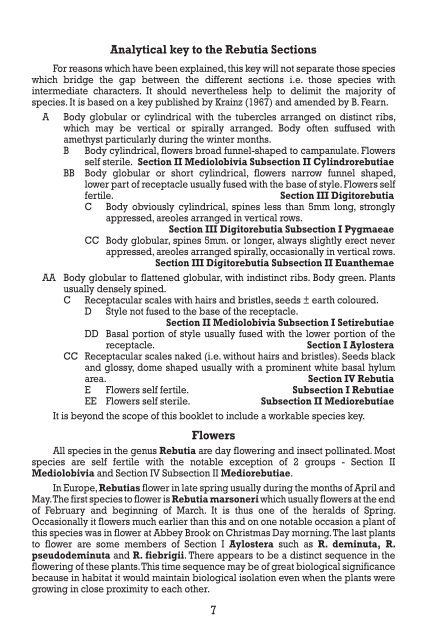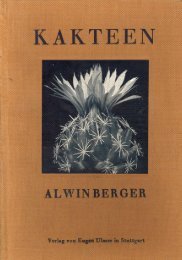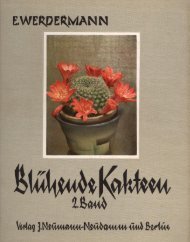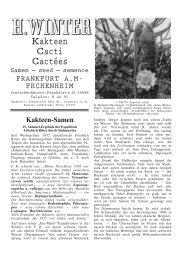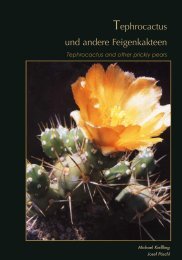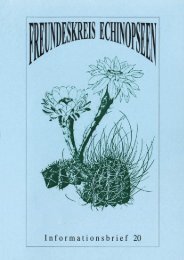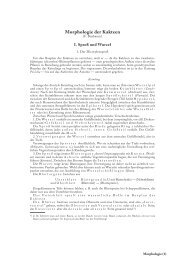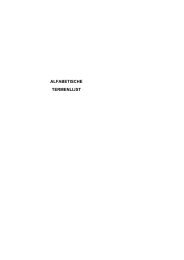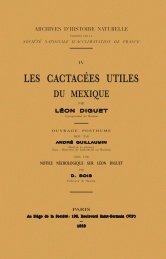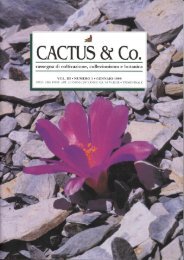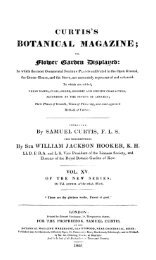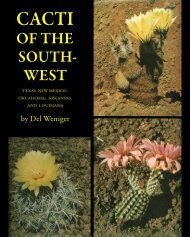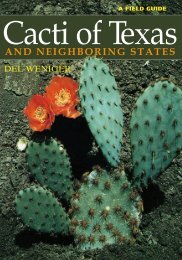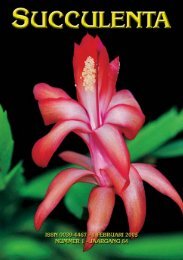the genus rebutia 1895—1981 - Free
the genus rebutia 1895—1981 - Free
the genus rebutia 1895—1981 - Free
You also want an ePaper? Increase the reach of your titles
YUMPU automatically turns print PDFs into web optimized ePapers that Google loves.
companulate -><br />
campanulate<br />
Analytical key to <strong>the</strong> Rebutia Sections<br />
For reasons which have been explained, this key will not separate those species<br />
which bridge <strong>the</strong> gap between <strong>the</strong> different sections i.e. those species with<br />
intermediate characters. It should never<strong>the</strong>less help to delimit <strong>the</strong> majority of<br />
species. It is based on a key published by Krainz (1967) and amended by B. Fearn.<br />
A Body globular or cylindrical with <strong>the</strong> tubercles arranged on distinct ribs,<br />
which may be vertical or spirally arranged. Body often suffused with<br />
amethyst particularly during <strong>the</strong> winter months.<br />
B Body cylindrical, flowers broad funnel-shaped to campanulate. Flowers<br />
self sterile. Section II Mediolobivia Subsection II Cylindro<strong>rebutia</strong>e<br />
BB Body globular or short cylindrical, flowers narrow funnel shaped,<br />
lower part of receptacle usually fused with <strong>the</strong> base of style. Flowers self<br />
fertile. Section III Digito<strong>rebutia</strong><br />
C Body obviously cylindrical, spines less than 5mm long, strongly<br />
appressed, areoles arranged in vertical rows.<br />
Section III Digito<strong>rebutia</strong> Subsection I Pygmaeae<br />
CC Body globular, spines 5mm. or longer, always slightly erect never<br />
appressed, areoles arranged spirally, occasionally in vertical rows.<br />
Section III Digito<strong>rebutia</strong> Subsection II Euan<strong>the</strong>mae<br />
AA Body globular to flattened globular, with indistinct ribs. Body green. Plants<br />
usually densely spined.<br />
C Receptacular scales with hairs and bristles, seeds ± earth coloured.<br />
D Style not fused to <strong>the</strong> base of <strong>the</strong> receptacle.<br />
Section II Mediolobivia Subsection I Seti<strong>rebutia</strong>e<br />
DD Basal portion of style usually fused with <strong>the</strong> lower portion of <strong>the</strong><br />
receptacle. Section I Aylostera<br />
CC Receptacular scales naked (i.e. without hairs and bristles). Seeds black<br />
and glossy, dome shaped usually with a prominent white basal hylum<br />
area. Section IV Rebutia<br />
E Flowers self fertile. Subsection I Rebutiae<br />
EE Flowers self sterile. Subsection II Medio<strong>rebutia</strong>e<br />
It is beyond <strong>the</strong> scope of this booklet to include a workable species key.<br />
Flowers<br />
All species in <strong>the</strong> <strong>genus</strong> Rebutia are day flowering and insect pollinated. Most<br />
species are self fertile with <strong>the</strong> notable exception of 2 groups - Section II<br />
Mediolobivia and Section IV Subsection II Medio<strong>rebutia</strong>e.<br />
In Europe, Rebutias flower in late spring usually during <strong>the</strong> months of April and<br />
May. The first species to flower is Rebutia marsoneri which usually flowers at <strong>the</strong> end<br />
of February and beginning of March. It is thus one of <strong>the</strong> heralds of Spring.<br />
Occasionally it flowers much earlier than this and on one notable occasion a plant of<br />
this species was in flower at Abbey Brook on Christmas Day morning. The last plants<br />
to flower are some members of Section I Aylostera such as R. deminuta, R.<br />
pseudodeminuta and R. fiebrigii. There appears to be a distinct sequence in <strong>the</strong><br />
flowering of <strong>the</strong>se plants. This time sequence may be of great biological significance<br />
because in habitat it would maintain biological isolation even when <strong>the</strong> plants were<br />
growing in close proximity to each o<strong>the</strong>r.<br />
7<br />
hylam -><br />
hylum


